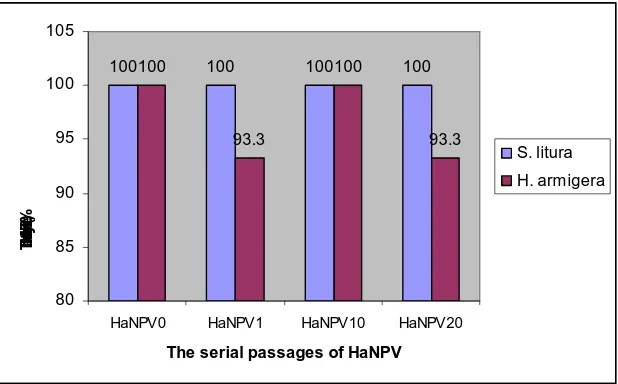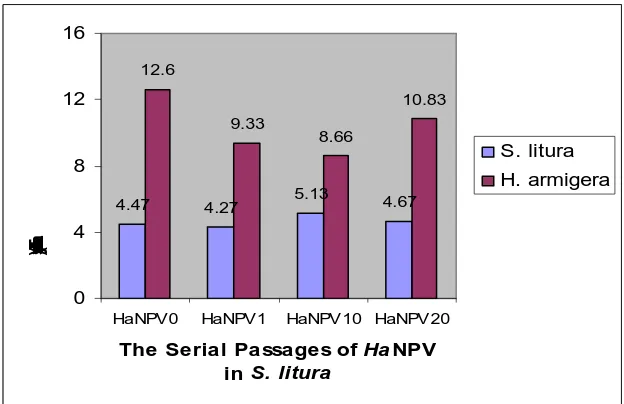In Vivo Production of Helicoverpa armigera Nuclear Polyhedrosis Virus (HaNPV) in Spodoptera litura : The Effect of Viral Serial Passages in S. litura on production
and Pathogenicity of the Virus to H. armigera.
Mia Miranti1 and Wardono Niloperbowo2
1.Department of Biologi, Faculty of Mathematics and Natural Sciences, University of Padjadjaran, Jl. Raya Bandung Sumedang km 21 Jatinangor Sumedang 45363, Indonesia 2.School of Life Sciences and Technology, Institut Teknologi Bandung, Jl. Ganesha 10 Bandung 40132, Indonesia
ABSTRACT
Previous studies on our Indonesian isolate of Helicoverpa armigera Nuclear Polyhedrosis Virus (HaNPV) isolated from cadaver of Helicoverpa armigera, indicates that the virus exhibits a great potential to be used as bioinsecticide to control population of Helicoverpa armigera. The use of insect virus as biological control agent is still limited, partly due to problems related to the difficulties in virus production. For HaNPV in particular, invitro production is hinderd by the high production cost, while invivo production techniques is difficult to perform, since Helicoverpa armigera larvae used for production host exhibits canibal behaviour, thus have to be reared individually. Previous studies shows that Spodoptera litura is also pathogenic HaNPV, that it can be used as a host for HaNPV invivo production. This research study the effect of HaNPV serial passages in S. litura on production and pathogenicity of the virus to H. armigera to determine the effect of HaNPV serial passage in Spodotera litura on the production of
HaNPV and pathogenicity of the resulting HaNPV to Helicoverpa armigera. The result
indicates that HaNPV subcultured in Spodoptera litura exhibited a similar patogenicity to
Spodoptera litura compared to that subcultured in Helicoverpa armigera. Third instar of Spodoptera litura infected with HaNPV0, HaNPV1, HaNPV10 and HaNPV20 exhibit an average larval death of 12,6 days, 9.33 days, 8.66 days and 10.83 days respectively. Furthermore, the level of viral production was not influenced by the level of HaNPV subcultures in Spodoptera litura. Third instar of Spodoptera litura infected with
HaNPV0, HaNPV1, HaNPV10 and HaNPV20 exhibit HaNPV production of 0.126 X 1010 PIB/ind, 2.65 X 1010 PIB/ind, 2.02 X 1010 PIB/ind, and 2,97 X 1010 PIB/ind. The result indicates that HaNPV repeated subcultures in Spodoptera litura do not change the pathogenicity of the virus to Spodotera litura and level of viral replication capacity of the virus. However further observation on the morphology of the polyhedra indicates that there are chages, possibly mutation, on HaNPV subcultured in Spodoptera litura. The polyhedra tend to deformed as the level of subculture increased. Further investigation showed that the polyhedral deformation does not alter the pathogenicity of HaNPV to
Helicoverpa armigera. Mortality data shows that infection HaNPV0, HaNPV1, HaNPV10 and HaNPV20 to third instar of Helicoverpa armigera larvae led to a similar mortality rate ie : 100%, 93.33%, 100% and 93.33% respectively.
Background
Previous studies on our Indonesian isolate of Helicoverpa armigera Nuclear
Polyhedrosis Virus (HaNPV) isolated from cadaver of Helicoverpa armigera, indicates
that the virus exhibits a great potential to be used as bioinsecticide to control population
of Helicoverpa armigera (Sanjaya, 2000 ; Miranti, 2001). Despite of this promising
potential, the use of insect virus as biological control agent is still limited, partly due to
problems related to the difficulties in virus production. For HaNPV in particular, invitro
production is hinderd by the high production cost, while invivo production techniques is
difficult to perform, since Helicoverpa armigera larvae used for production host exhibits
canibal behaviour, thus have to be reared individually (Miranti, et al., 2007; Wahyuni,
2007). Previous studies shows that Spodoptera litura is also pathogenic HaNPV, that it
can be used as a host for HaNPV invivo production (Miranti, 2008). However, a number
of studies indicates that viral serial passages led to mutation and reduction of
pathogenicity (Chakraborty and Reid, 1999 : Moscardi, 1999). This research study the
effect of HaNPV serial passages in S. litura on production and pathogenicity of the virus
to H. armigera
Objective
The main objective of this research is to determine the effect of HaNPV serial
passages in Spodotera litura on the production of HaNPV and pathogenicity of the
resulting HaNPV to Helicoverpa armigera.
Method
The HaNPV was kindly provided by The Centre of Life Sciences, Institut
Teknologi Bandung (ITB). It is a wild type nucleopolyhedrosis virus isolated from
cadaver of Helicoverpa armigera collected from tomato farm in Lembang, West Java,
Indonesia. The HaNPV used for this study was propagated in Helicoverpa armigera and
Spodoptera litura. HaNPV0 was prepared by propagating the HaNPV in Helicoverpa
armigera, the HaNPV1 was prepared by propagating the HaNPV in Spodoptera litura
and isolated after only 1 passage, the HaNPV10 was prepared by propagating the HaNPV
propagating the HaNPV in Spodoptera litura and isolated after 20 passages. The HaNPV
were isolated acording to O’reilly, et al., (1994) and the HaNPV stock solutions were
prepared to contain 4 X 107 polyhedral inclusion body/ml. Larval infection were carried
out orally through feed contamination method, by mixing 30 gram of sweet corn kernel
(larval feed) with 1 ml of various HaNPV stocks.
Third instars larval of S. litura and the parents of H. armigera are result from
rearing in a laboratorium obtained from Vegetables Research Center (Balai Penelitian
Sayuran) in Lembang.
Result
The result indicates that the serial passages of HaNPV subcultured in Spodoptera
litura exhibited a similar patogenicity to Spodoptera litura compared to that subcultured
in Helicoverpa armigera (Fig. 1).
100100 100 100 100
93.3
100
93.3
80 85 90 95 100 105
HaNPV0 HaNPV1 HaNPV10 HaNPV20
The serial passages of HaNPV
The M
ortalit
y Rate
(%)
S. litura H. armigera
Figure. 1. The effect of serial passages of HaNPV against the mortality rate of S.litura and H. armigera larvae
The mortality rate of S. litura which infected by HaNPV from serial passages in
S. litura is average 100 %. It shows that serial passages of HaNPV was effective to kill
S. litura which used as a host for virus production. The level of patogenicity of HaNPV
Thiem, (1997), said that the virus could be replicated in the cells from the
alternate host for virus production. The level of mortality rate (up to 100%), shows that
the alternate host is sensitive against viral infection. Stairs, (1991), found that the serial
passages of virus in alternate host will increase the virus virulent against alternate host
itself.
Third instar of H. armigera infected with HaNPV0, HaNPV1, HaNPV10 and
HaNPV20 exhibit an average larval death of 12,6 days, 9.33 days, 8.66 days and 10.83
days respectively (Fig. 2). The serial passages of HaNPV in S. litura tends to reduce the
lethal time of H. armigera infected larval. Harrison dan Summer, (1995), said that the
effect of serial passages of virus led the faster of the lethal time of non main host, because
the virus produce the most infected mutagenic virion.
4.47 4.27
5.13
4.67 12.6
9.33
8.66
10.83
0 4 8 12 16
HaNPV0 HaNPV1 HaNPV10 HaNPV20
The Serial Pa ssages of Ha NPV in S. litura
Lethal Time (days)
S. litura H. armigera
Figure 2. The effect of serial passages of HaNPV in S. litura against to the lethal time of S. litura and H. armigera.
The figure 2, shows that the virus infection tends more effective to reduce lethal
time against S. litura than H. armigera. The short lethal time against S. litura means that
the production of HaNPV in S. litura more effectively to harvest the production of virus.
Stairs, (1991), found that third times serial passages of Bombyx mori NPV
Furthermore, the level of viral production was not influenced by the level of
HaNPV subcultures in Spodoptera litura. The production of virus is the count of the
polyhedral of virus which produced in cadaver of larval which infected by virus. The
level of polyhedral will increase if the larval died. The production of polyhedral from
cadaver of larval a day shows in Table 1.
Table 1. The effect of serial passages of HaNPV in S. litura against HaNPV polyhedral production.
The Serial Passages of
HaNPV in S. litura
Polihedral Inclusion Bodies (PIB) Production
(PIB/individual)
Lethal Time (average)
(days)
HaNPV0 0.126 X 1010 5
HaNPV1 2.65 X 1010 5
HaNPV10 2.02 X 1010 5
HaNPV 20 2.97 X 1010 5
Table 1, shows that the serial passages of HaNPV is increase the production of
the virus. Third instar of Spodoptera litura infected with HaNPV0, HaNPV1, HaNPV10
and HaNPV20 exhibit HaNPV production of 0.126 X 1010 PIB/ind, 2.65 X 1010 PIB/ind,
2.02 X 1010 PIB/ind, and 2,97 X 1010 PIB/ind. The result of the research shows that the
serial passages of HaNPV in S. litura up to 20th times tends the stability of virus
production.
Then, the researchers found that the sustainable serial passages of virus in
alternate host led the mutation of virus and reduced the level of patogenicity of the virus
to the main host and reduced the level of virus production (Chakraborty and Reid, 1999 :
Moscardi, 1999 ; Mulock and Faulkner, 1997 ; Narayanan, et al., 2002).
The result indicates that HaNPV repeated subcultures in Spodoptera litura do not
change the pathogenicity of the virus to Spodotera litura and level of viral replication
capacity of the virus.
However further observation on the morphology of the polyhedra indicates that
there are changes, possibly mutation, on HaNPV subcultured in Spodoptera litura. The
polyhedra tend to deformed as the level of subculture increased. Further investigation
Helicoverpa armigera. Mortality data (Fig. 1), shows that infection HaNPV0, HaNPV1,
HaNPV10 and HaNPV20 to third instar of Helicoverpa armigera larvae lead to a similar
mortality rate ie : 100%, 93.33%, 100% and 93.33% respectively.
Evans, (1981), and Stairs, (1991) said that the subculture virus had high
proliferation, and leds the high mortality level to the larvae, before pupation.
Conclusion :
1. HaNPV subculture in Spodoptera litura led to deformation of viral polyhedra.
However this does not lead to the reduction of HaNPV pathogenicty to
Spodoptera litura and viral production in Spodoptera litura.
2. The resulting HaNPV shows a similar pathogenicity to Helicoverpa armigera.
Reference :
1. Chakraborty, S and S. Reid. 1999. Serial Passage of a Helicoverpa armigera Nucleopolyhedrovirus in Helicoverpa zea cell Cultures. Journal of Invertebrate Pathology. 73 (3). 303-308.
2. Miranti, M. 2001. Pengaruh Dosis Helicoverpa armigera Nuclear Polyhedrosis Virus (HaNPV) dan Stadia Larva terhadap sifat Fisiologis dan Mortalitas Larva Helicoverpa armigera (Hubner). Tesis. Universitas Padjadjaran Bandung, Indonesia.
3. Miranti, M., E. Santosa, R. Setiamihardja., dan W. Niloperbowo. 2007. Kajian tentang Patogenisitas Helicoverpa armigera Nuclear Polyhedrosis Virus pada Beberapa Serangga. Prosiding Perhimpunan Entomologi Indonesia. 10-11 April 2007. Sukamandi Subang, Jawa Barat. Indonesia.
4. Miranti, M. 2008. Produksi Helicoverpa armigera Nuclear Polyhedrosis Virus (HaNPV) secara In Vivo pada Inang Pengganti. Disertasi. Universitas Padjadjaran Bandung, Indonesia.
5. Moscardi, 1999. Assesment of the Application of Baculoviruses for Control of Lepidoptera. Annual Review Entomology. 44. 257-289.
6.Mulock, B., and P. Faulkner. 1997. Field Studies of a Genetically Modified Baculovirus, Autographa californica Nuclear Polyhedrosis Virus. Journal of Invertebrate Pathology. 70. 33-40.
7.Narayanan, K., and S. Jayaraj. 2002. Mass Production of Polyhedral Occlusion Bodies of NPV of Helicoverpa armigera in Relation to Dose, Age, and Larval Weight. Indian J Exp Biol. 40(7). 846-849. http://www.medscape.com/medline/abstract diakses tanggal 10 Januari 2006.
8. O’reilly, D.R., L.K. Miller, and V.A. Luckow. 1994. Baculovirus Expression Vectors : A Laboratory Manual. Oxford University Press : New York.
10. Stairs, G.R. 1991. Quantitative Studies on The Infection of Galleria mellonella with Nuclear Polyhedrosis Virus of Bombyx mori. Journal of Invertebrate Pathology. 57. 402-405.
11. Wahyuni, W. 2007. Pengaruh Dosis Helicoverpa armigera Nuclear Polyhedrosis Virus (HaNPV) terhadap Produksi HaNPV pada Spodoptera litura Fabricius. Skripsi. Universitas Padjadjaran, Bandung. Indonesia.
Contact person : Mia Miranti ([email protected]), telp/fax :+62 022 7796412


